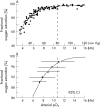Optimum oxygen therapy in preterm babies
- PMID: 17337663
- PMCID: PMC2675464
- DOI: 10.1136/adc.2005.092726
Optimum oxygen therapy in preterm babies
Abstract
Oxygen is the most commonly used therapy in neonatal nurseries as an integral part of respiratory support. The goal of oxygen therapy is to achieve adequate delivery of oxygen to the tissue without creating oxygen toxicity. Oxygen must have been given to newborn preterm babies more than any other medicinal product in the past 60 years. Despite this, we still know very little about how much oxygen these babies actually need, or how much oxygen is safe to give, especially in the first few weeks of life. Recent observational studies have raised concerns that giving oxygen to target the saturation at "physiological" levels in newborn preterm babies may do more harm than good, but to date, clinicians have not been able to resolve the uncertainties surrounding optimum oxygen therapy.
Conflict of interest statement
Competing interests: None declared.
References
-
- Priestley J.Experiments and observations on different kinds of air. London: J Johnson, 1775101
-
- Scheele K W.Chemical observations and experiments an air and fire.. Introduction by Torben Bergman. London: J Johnson, 1780
-
- Lavoisier A‐L. Experiences sur la respiration des animaux. Mém Soc Sci Paris 17802185
-
- Tin W, Hey E. The medical use of oxygen: a century of research in animals and humans. NeoReviews 20034e340–e349.
-
- Wilson J L, Long S B, Howard P J. Respiration of premature infants: response to variations of oxygen and to increased carbon dioxide in inspired air. Am J Dis Child 1942631080–1085.
Publication types
MeSH terms
Substances
LinkOut - more resources
Full Text Sources
Other Literature Sources
Medical
Miscellaneous


